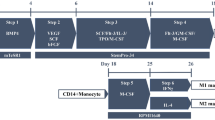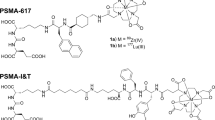Abstract
Purpose
Pluripotent stem cell (PSC)-based therapies possess great potential to restore the function of irreversibly damaged organs. PSCs can be differentiated in vitro into any cell type. However, pluripotent potential bears the risk of teratoma formation. In vivo monitoring of teratoma formation is indispensable, as 100 % purity of the cell preparation cannot be achieved. We aimed at establishing the human sodium iodide symporter (hNIS) as reporter gene for PET monitoring of teratoma formation.
Procedures
Murine PSC stably expressing hNIS were injected into the hind limbs of SCID mice to induce teratoma formation. Positron emission tomography (PET) scans were acquired weekly between days 14 and 42 after transplantation. Two teratomas were excised at each time point for histology and size measurement. Tracer uptake was correlated with teratoma weight. Specificity of tumoural iodine uptake was assessed by blocking hNIS in vivo with perchlorate.
Results
Neither hNIS expression nor I-124 exposure adversely impacted viability or differentiation potential of PSCs. Iodine uptake was highly specific in teratomas, as in vivo blocking of hNIS with perchlorate led to uptake rates comparable to tracer uptake in non-transgene tumours. Tumour mass and tracer uptake showed a positive correlation.
Conclusions
This is the first study to generate stably hNIS-expressing murine PSCs. Since the differentiation potential was preserved, hNIS-expressing cells are suitable for PSC-based forward programming approaches. Teratoma formation from undifferentiated cells can be monitored in vivo by PET with high specificity on a quantitative level. Due to its anticipated lack of immunogenicity in humans, hNIS is a promising reporter gene for clinical translation.







Similar content being viewed by others
Abbreviations
- %ID:
-
Percentage of the injected dose
- I-124:
-
Iodine-124
- I-125:
-
Iodine-125
- BMSC:
-
Bone marrow stem cells
- DMEM:
-
Dulbecco’s modified eagle medium
- EB:
-
Embryoid body
- ESC:
-
Embryonic stem cells
- [18F]FDG:
-
2-Deoxy-2-[18F]fluoro-d-glucose
- hNIS:
-
Human sodium iodide symporter
- iPS:
-
Induced pluripotent stem cells
- LAD:
-
Left anterior descending artery
- MAP:
-
Maximum a posteriori
- MI:
-
Myocardial infarction
- OSEM:
-
Ordered subset expectation maximization
- PBS:
-
Phosphate buffered saline
- PET:
-
Positron emission tomography
- PFA:
-
Paraformaldehyde
- PSC:
-
Pluripotent stem cells
- SCID:
-
Severe combined immunodeficiency
- VOI:
-
Volume of interest
- [18F]FHBG:
-
9-(4-[18F]fluoro-3-[hydroxymethyl]butyl)guanine
References
David R, Stieber J, Fischer E et al (2009) Forward programming of pluripotent stem cells towards distinct cardiovascular cell types. Cardiovasc Res 84:263–272
Yang D, Zhang Z-J, Oldenburg M et al (2008) Human embryonic stem cell-derived dopaminergic neurons reverse functional deficit in parkinsonian rats. Stem Cells 26:55–63
Craft AM, Ahmed N, Rockel JS et al (2013) Specification of chondrocytes and cartilage tissues from embryonic stem cells. Development 140:2597–2610
Mauritz C, Schwanke K, Reppel M et al (2008) Generation of functional murine cardiac myocytes from induced pluripotent stem cells. Circulation 118:507–517
Roessler R, Smallwood SA, Veenvliet JV et al (2014) Detailed analysis of the genetic and epigenetic signatures of iPSC-derived mesodiencephalic dopaminergic neurons. Stem Cell Rep 2:520–533
Wei Y, Zeng W, Wan R et al (2012) Chondrogenic differentiation of induced pluripotent stem cells from osteoarthritic chondrocytes in alginate matrix. Eur Cell Mater 23:1–12
Ieda M, Fu J-D, Delgado-Olguin P et al (2010) Direct reprogramming of fibroblasts into functional cardiomyocytes by defined factors. Cell 142:375–386
Caiazzo M, Dell’Anno MT, Dvoretskova E et al (2011) Direct generation of functional dopaminergic neurons from mouse and human fibroblasts. Nature 476:224–227
Outani H, Okada M, Yamashita A et al (2013) Direct induction of chondrogenic cells from human dermal fibroblast culture by defined factors. PLoS ONE 8, e77365
Kolossov E, Bostani T, Roell W et al (2006) Engraftment of engineered ES cell-derived cardiomyocytes but not BM cells restores contractile function to the infarcted myocardium. J Exp Med 203:2315–2327
Moon J, Lee H-S, Kang JM et al (2013) Stem cell grafting improves both motor and cognitive impairments in a genetic model of Parkinson’s disease, the aphakia (ak) mouse. Cell Transplant 22:1263–1279
Marini JC, Forlino A (2012) Replenishing cartilage from endogenous stem cells. N Engl J Med 366:2522–2524
Atala A (2012) Human embryonic stem cells: early hints on safety and efficacy. Lancet 379:689–690
Cyranoski D (2013) Stem cells cruise to clinic. Nature 494:413
David R, Schwarz F, Rimmbach C et al (2013) Selection of a common multipotent cardiovascular stem cell using the 3.4-kb MesP1 promoter fragment. Basic Res Cardiol 108:312
Bondue A, Tännler S, Chiapparo G et al (2011) Defining the earliest step of cardiovascular progenitor specification during embryonic stem cell differentiation. J Cell Biol 192:751–765
Su W, Zhou M, Zheng Y et al (2011) Bioluminescence reporter gene imaging characterize human embryonic stem cell-derived teratoma formation. J Cell Biochem 112:840–848
Cao F, Li Z, Lee A et al (2009) Noninvasive de novo imaging of human embryonic stem cell-derived teratoma formation. Cancer Res 69:2709–2713
Cao F, Lin S, Xie X et al (2006) In vivo visualization of embryonic stem cell survival, proliferation, and migration after cardiac delivery. Circulation 113:1005–1014
Pomper MG, Hammond H, Yu X et al (2009) Serial imaging of human embryonic stem-cell engraftment and teratoma formation in live mouse models. Cell Res 19:370–379
Dohán O, la Vieja DA, Paroder V et al (2003) The sodium/iodide Symporter (NIS): characterization, regulation, and medical significance. Endocr Rev 24:48–77
Terrovitis J, Kwok KF, Lautamäki R et al (2008) Ectopic expression of the sodium-iodide symporter enables imaging of transplanted cardiac stem cells in vivo by single-photon emission computed tomography or positron emission tomography. J Am Coll Cardiol 52:1652–1660
Miyagawa M, Anton M, Wagner B et al (2005) Non-invasive imaging of cardiac transgene expression with PET: comparison of the human sodium/iodide symporter gene and HSV1-tk as the reporter gene. Eur J Nucl Med Mol Imaging 32:1108–1114
Müller M, Fleischmann BK, Selbert S et al (2000) Selection of ventricular-like cardiomyocytes from ES cells in vitro. FASEB J 14:2540–2548
David R, Jarsch VB, Schwarz F et al (2011) Induction of MesP1 by Brachyury(T) generates the common multipotent cardiovascular stem cell. Cardiovasc Res 92:115–122
Spitzweg C, Baker CH, Bergert ER et al (2007) Image-guided radioiodide therapy of medullary thyroid cancer after carcinoembryonic antigen promoter-targeted sodium iodide symporter gene expression. Hum Gene Ther 18:916–924
Scholz IV, Cengic N, Baker CH et al (2005) Radioiodine therapy of colon cancer following tissue-specific sodium iodide symporter gene transfer. Gene Ther 12:272–280
Klutz K, Russ V, Willhauck MJ et al (2009) Targeted radioiodine therapy of neuroblastoma tumors following systemic nonviral delivery of the sodium iodide symporter gene. Clin Cancer Res 15:6079–6086
Thomson JA, Itskovitz-Eldor J, Shapiro SS et al (1998) Embryonic stem cell lines derived from human blastocysts. Science 282:1145–1147
Frantz S (2012) Embryonic stem cell pioneer Geron exits field, cuts losses. Nat Biotechnol 30:12–13
Amariglio N, Hirshberg A, Scheithauer BW et al (2009) Donor-derived brain tumor following neural stem cell transplantation in an ataxia telangiectasia patient. PLoS Med 6, e1000029
Schwartz SD, Hubschman J-P, Heilwell G et al (2012) Embryonic stem cell trials for macular degeneration: a preliminary report. Lancet 379:713–720
Lukovic D, Stojkovic M, Moreno-Manzano V et al (2014) Perspectives and future directions of human pluripotent stem cell-based therapies: lessons from Geron’s clinical trial for spinal cord injury. Stem Cells Dev 23:1–4
Lee AS, Tang C, Cao F et al (2009) Effects of cell number on teratoma formation by human embryonic stem cells. Cell Cycle 8:2608–2612
Knoepfler PS (2009) Deconstructing stem cell tumorigenicity: a roadmap to safe regenerative medicine. Stem Cells 27:1050–1056
Prokhorova TA, Harkness LM, Frandsen U et al (2009) Teratoma formation by human embryonic stem cells is site dependent and enhanced by the presence of Matrigel. Stem Cells Dev 18:47–54
Castro CA, Ben-Yehudah A, Ozolek JA et al (2010) Semiquantitative histopathology and 3D magnetic resonance microscopy as collaborative platforms for tissue identification and comparison within teratomas derived from pedigreed primate embryonic stem cells. Stem Cell Res 5:201–211
Lee AS, Tang C, Rao MS et al (2013) Tumorigenicity as a clinical hurdle for pluripotent stem cell therapies. Nat Med 19:998–1004
Baril P, Martin-Duque P, Vassaux G (2010) Visualization of gene expression in the live subject using the Na/I symporter as a reporter gene: applications in biotherapy. Br J Pharmacol 159:761–771
Yaghoubi SS, Campbell DO, Radu CG, Czernin J (2012) Positron emission tomography reporter genes and reporter probes: gene and cell therapy applications. Theranostics 2:374–391
Chen EQ, MacIntyre WJ, Go RT et al (1997) Myocardial viability studies using fluorine-18-FDG SPECT: a comparison with fluorine-18-FDG PET. J Nucl Med 38:582–586
Knesaurek K, Machac J (2006) Comparison of 18F SPECT with PET in myocardial imaging: a realistic thorax-cardiac phantom study. BMC Nucl Med 6:5
Valentin J (2003) Relative biological effectiveness (RBE), quality factor (Q), and radiation weighting factor (wR). Ann ICRP 33:1–121
Protection R (2007) ICRP Publication 103. Ann ICRP
Freudenberg LS, Jentzen W, Stahl A et al (2011) Clinical applications of 124I-PET/CT in patients with differentiated thyroid cancer. Eur J Nucl Med Mol Imaging 38(Suppl 1):S48–S56
Templin C, Zweigerdt R, Schwanke K et al (2012) Transplantation and tracking of human-induced pluripotent stem cells in a pig model of myocardial infarction: assessment of cell survival, engraftment, and distribution by hybrid single photon emission computed tomography/computed tomography of sodium iodide symporter transgene expression. Circulation 126:430–439
Rodriguez-Porcel M (2010) In vivo imaging and monitoring of transplanted stem cells: clinical applications. Curr Cardiol Rep 12:51–58
Wu JC, Spin JM, Cao F et al (2006) Transcriptional profiling of reporter genes used for molecular imaging of embryonic stem cell transplantation. Physiol Genomics 25:29–38
Wu JC, Cao F, Dutta S et al (2006) Proteomic analysis of reporter genes for molecular imaging of transplanted embryonic stem cells. Proteomics 6:6234–6249
Lubberink M, Herzog H (2011) Quantitative imaging of 124I and 86Y with PET. Eur J Nucl Med Mol Imaging 38(Suppl 1):S10–S18
Acknowledgments
We thank Christiane Groß, Barbara Markieton and Judith Arcifa for the expert technical assistance. This work was supported by the FöFoLe Program of the LMU Munich [C.L. and W.M.F.], the BMBF [01GN0960 to R.D. and W.M.F.] and the Deutsche Forschungsgemeinschaft [DA 1296/2-1 to R.D. and FR 705/14-2 to W.M.F.]. This work has been funded by the Federal Ministry of Education and Research Germany (FKZ 0312138A and FKZ 316159) and the State Mecklenburg-Western Pomerania with EU Structural Funds (ESF/IV-WM-B34-0030/10 and ESF/IV-BM-B35-0010/12), by the DFG (DA 1296-1) and the German Heart Foundation (F/01/12). A substantial part of this work originated from the doctoral thesis of Georgios Kaissis.
Conflict of Interest
The authors declare that they have no conflict of interest.
Author information
Authors and Affiliations
Corresponding author
Additional information
Robert David and Marcus Hacker share senior authorships.
Sebastian Lehner and Cajetan Lang contributed equally to this work.
Electronic supplementary material
Below is the link to the electronic supplementary material.
EB’s from transgenic ESC’s retained their cardiogenic potential in vitro, as evident from spontaneously contracting foci that occurred on day 12 of differentiation (A,B). (M4V 5188 kb)
Rights and permissions
About this article
Cite this article
Lehner, S., Lang, C., Kaissis, G. et al. 124I-PET Assessment of Human Sodium Iodide Symporter Reporter Gene Activity for Highly Sensitive In Vivo Monitoring of Teratoma Formation in Mice. Mol Imaging Biol 17, 874–883 (2015). https://doi.org/10.1007/s11307-015-0857-1
Published:
Issue Date:
DOI: https://doi.org/10.1007/s11307-015-0857-1




